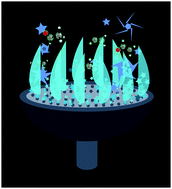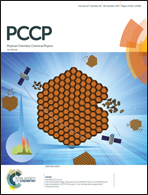Radicals derived from acetaldehyde and vinyl alcohol†
Abstract
Vinyl alcohol and acetaldehyde are isoelectronic products of incomplete butanol combustion. Along with the radicals resulting from the removal of atomic hydrogen or the hydroxyl radical, these species are studied here using ab initio methods as complete as coupled cluster theory with single, double, triple, and perturbative quadruple excitations [CCSDT(Q)], with basis sets as large as cc-pV5Z. The relative energies provided herein are further refined by including corrections for relativistic effects, the frozen core approximation, and the Born–Oppenheimer approximation. The effects of anharmonic zero-point vibrational energies are also treated. The syn conformer of vinyl alcohol is predicted to be lower in energy than the anti conformer by 1.1 kcal mol−1. The alcoholic hydrogen of syn-vinyl alcohol is found to be the easiest to remove, requiring 84.4 kcal mol−1. Five other radicals are also carefully considered, with four conformers investigated for the 1-hydroxyvinyl radical. Beyond energetics, we have conducted an overhaul of the spectroscopic literature for these species. Our results also provide predictions for fundamental modes yet to be reported experimentally. To our knowledge, the ν3 (3076 cm−1) and ν4 (2999 cm−1) C–H stretches for syn-vinyl alcohol and all but one of the vibrational modes for anti-vinyl alcohol (ν1–ν14) are yet to be observed experimentally. For the acetyl radical, ν6 (1035 cm−1), ν11 (944 cm−1), ν12 (97 cm−1), and accounting for our changes to the assignment of the 1419.9 cm−1 experimental mode, ν10 (1441 cm−1), are yet to be observed. We have predicted these unobserved fundamentals and reassigned the experimental 1419.9 cm−1 frequency in the acetyl radical to ν4 rather than to ν10. Our work also strongly supports reassignment of the ν10 and ν11 fundamentals of the vinoxy radical. We suggest that the bands assigned to the overtones of these fundamentals were in fact combination bands. Our findings may be useful in constructing improved combustion models of butanol and in spectroscopically characterizing these molecules further.



 Please wait while we load your content...
Please wait while we load your content...